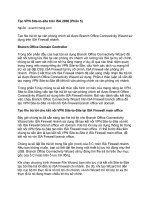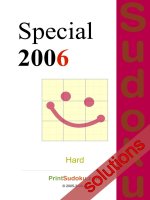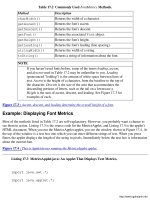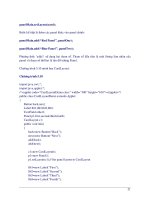Pro XML Development with Java Technology 2006 phần 5 ppt
Bạn đang xem bản rút gọn của tài liệu. Xem và tải ngay bản đầy đủ của tài liệu tại đây (1.3 MB, 36 trang )
CHAPTER 5 ■ TRANSFORMING WITH XSLT
135
Summary
XSLT is a language for transforming XML documents to other XML documents or non-XML docu-
ments such as HTML or plain-text documents. To apply transformations described in an XSLT style
sheet to an XML document, you need an XSLT processor and an API to invoke the XSLT processor.
The TrAX API set available within JAXP 1.3 is ideally suited for transforming an input XML docu-
ment using an XSLT style sheet. The type of target output document types produced by an XSLT style
sheet is limited only by your imagination. In this chapter, we showed how to successfully transform
XML documents into other XML documents, HTML documents, and plain-text documents.
Vohra_706-0C05.fm Page 135 Thursday, July 6, 2006 1:42 PM
Vohra_706-0C05.fm Page 136 Thursday, July 6, 2006 1:42 PM
■ ■ ■
PART 2
Object Bindings
Vohra_706-0C06.fm Page 137 Thursday, July 13, 2006 1:11 PM
Vohra_706-0C06.fm Page 138 Thursday, July 13, 2006 1:11 PM
139
■ ■ ■
CHAPTER 6
Object Binding with JAXB
XML is a simple, flexible, platform-independent language for representing structured textual
information. The platform-independent nature of XML makes it an ideal vehicle for exchanging data
across application components. When disparate application components exchange XML-based
data, they do so because they want to process the exchanged data in some application-specific
manner, such as extracting and storing the data in a database or maybe formatting and presenting
the data as part of a user interface. This raises an interesting point: although XML is ideal for exchanging
data, processing XML content using the various APIs we have discussed in the preceding chapters
can be highly inefficient. Why is that so?
The answer is that most processing logic today resides within application components that are
object oriented, whereas processing XML content is extremely procedural in nature. Each compo-
nent that wants to process some XML content has to not only be concerned that the content is well-
formed but also that it conforms to some specific structure (or, in other words, is valid with respect
to some schema). Furthermore, once the component has verified that the XML content is well-formed
and valid, it has to use an appropriate API to access the data embedded within the XML content.
Of course, it can certainly do all that—in previous chapters, we discussed how to parse and vali-
date XML content and how to access and modify data embedded within XML content by using the
appropriate APIs, but directly using these APIs within most object-oriented applications can be
highly inefficient from the point of view of encapsulation and code reuse. To address the inefficiencies
associated with directly processing XML content within object-oriented Java applications, you need
a Java API that transparently maps XML content to Java objects and Java objects to XML content.
Java Architecture for XML Binding (JAXB) is precisely such an API.
Overview
The key to understanding JAXB is to focus on the following points:
• Given an XML Schema document, an infinite number of XML documents can be constructed
that would be valid with respect to the given schema.
• Given a schema and an XML document that conforms to the given schema, an element within
the given XML document must conform to a type component specified within the given
schema.
• What an object instance is to its corresponding class within Java, an element in an XML docu-
ment is to an element declaration specified within the document’s schema.
Vohra_706-0C06.fm Page 139 Thursday, July 13, 2006 1:11 PM
140
CHAPTER 6
■ OBJECT BINDING WITH JAXB
• Each type component (with some exceptions) specified within a schema can be mapped to a
Java class. This Java class may already exist as part of the Java platform, or it may need to be
defined as a new class.
• The process of binding schema type components to various Java class definitions is at the
core of JAXB.
The JAXB API was developed as a part of the Java Community Process.
1
It is important to note
that at the time of writing this book, two versions of JAXB were available:
• The first available version is JAXB 1.0, which was finalized in January 2003. An implementa-
tion of this specification is available in Java Web Services Developer Pack (JWSDP) 1.6 and
also in J2EE 1.4.
• The second available version is JAXB 2.0, which was finalized in May 2006. An implementa-
tion of this specification is available in JWSDP 2.0 and also in Java Enterprise Edition 5.
The principal objectives of JAXB are unchanged from JAXB 1.0 to 2.0. However, 2.0 has a
number of significant additions. So, we will first discuss JAXB 1.0 in detail and then discuss the
significant additions made in JAXB 2.0.
JAXB 1.0
In the following sections, we will cover JAXB 1.0.
Architecture
Figure 6-1 shows the basic architecture of JAXB 1.0. JAXB binds a source XML Schema to a set of
schema-derived Java content classes. A binding compiler (xjc) within JAXB generates Java content
classes corresponding to top-level type components specified within the source schema. A runtime-
binding framework API available within JAXB marshals and unmarshals an XML document from and
to its corresponding Java objects.
Figure 6-1. JAXB 1.0 architecture
1. Information about this process is available at />Vohra_706-0C06.fm Page 140 Thursday, July 13, 2006 1:11 PM
CHAPTER 6 ■ OBJECT BINDING WITH JAXB
141
It is important to note that the JAXB 1.0 binding compiler does not support the mapping of
every type of XML Schema component. In fact, the following XML Schema
2
components are not
supported in JAXB 1.0:
• Element declarations using the substitutionGroup attribute, which is resolved to a
predefined model group schema component (<xs:element @substitutionGroup>).
• Wildcard schema components (xs:any and xs:anyAttribute).
• Identity constraints used to specify uniqueness across multiple elements (xs:key, xs:keyref,
and xs:unique).
• Redefined XML Schema components using the redefine declaration (<xs:redefine>).
• Notation XML Schema components (<xs:notation>).
• The following schema attributes are not supported: complexType.abstract, element.abstract,
element.substitutionGroup, xsi:type, complexType.block, complexType.final, element.block,
element.final, schema.blockDefault, and schema.finalDefault.
XML Schema Binding to Java Representation
JAXB 1.0 defines a default binding of the supported schema subset to Java. However, you can over-
ride this default binding through external binding declarations, which you can specify inline in the
schema or in a separate XML binding declaration document. Either way, the binding declarations
override the default XML Schema to Java bindings.
The detailed algorithms that bind the XML Schema subset to Java are best left to the JAXB 1.0
specification. Having said that, we will quickly add that these details will be of limited value to you if
your sole interest lies in applying JAXB, not in implementing JAXB. Therefore, instead of covering all
the details associated with the schema binding to Java, we will help you develop an intuitive under-
standing of the schema binding by presenting a simple example.
Simple Binding Example
Say you have a simple schema that specifies a structure for a postal address within the United States
or Canada. It specifies the obvious elements such as name, street, city, and state. It specifies a choice
of either U.S. ZIP code or Canadian postal code. It constrains the country element content to be
either United States or Canada. Listing 6-1 shows an example of such a schema.
Listing 6-1. U.S. or Canadian Address Schema: address.xsd
<?xml version='1.0' encoding='UTF-8' ?>
<xs:schema jxb:version="1.0"
xmlns:jxb=" /> xmlns:xs=" /> xmlns:xsi=" /> xsi:schemaLocation=" /> >
<xs:element name="UsOrCanadaAddress" >
<xs:complexType>
2. You can find detailed information about XML Schema components at />Vohra_706-0C06.fm Page 141 Thursday, July 13, 2006 1:11 PM
142
CHAPTER 6
■ OBJECT BINDING WITH JAXB
<xs:sequence>
<xs:element name="name" type="xs:string" ></xs:element>
<xs:element name="street" type="xs:string" ></xs:element>
<xs:element name="city" type="xs:string" ></xs:element>
<xs:element name="state" type="xs:string" ></xs:element>
<xs:choice>
<xs:element name="zip" type="xs:int" ></xs:element>
<xs:element name="postalCode" type="xs:string" ></xs:element>
</xs:choice>
<xs:element name="country" >
<xs:simpleType>
<xs:restriction base="xs:string" >
<xs:enumeration value="United States" ></xs:enumeration>
<xs:enumeration value="Canada" ></xs:enumeration>
</xs:restriction>
</xs:simpleType>
</xs:element>
</xs:sequence>
</xs:complexType>
</xs:element>
</xs:schema>
Now, to keep things simple, you will accept all the default XML Schema binding rules, except for
one. You will override the default package name for generated Java classes and interfaces with a
specific package name, com.apress.jaxb1.example, as in the external binding file shown in Listing 6-2.
Listing 6-2. External Binding Declaration for a Package Name
<?xml version='1.0' encoding='utf-8' ?>
<jxb:bindings version="1.0"
xmlns:jxb=" /> xmlns:xs=" >
<jxb:bindings node="/xs:schema" schemaLocation="address.xsd" >
<jxb:schemaBindings>
<jxb:package name="com.apress.jaxb1.example" ></jxb:package>
</jxb:schemaBindings>
</jxb:bindings>
</jxb:bindings>
Later in this chapter, in the “Binding the Catalog Schema to Java Classes” section, we will discuss
in detail how to configure and run the xjc compiler from within Eclipse. For now, assume you know
how to do that, and run the xjc compiler so it consumes the schema in Listing 6-1 and the external
binding declarations in Listing 6-2. Running xjc binds the schema components to Java. For the schema
shown in Listing 6-1, the xjc schema binding works as follows:
•In the com.apress.jaxb1.example package, xjc generates two Java interfaces and one Java
class. The interfaces are UsOrCanadaAddressType and UsOrCanadaAddress, and the class is
ObjectFactory.
•The UsOrCanadaAddressType interface is the Java representation for the <xs:complexType>
component defined within the <xs:element name="UsOrCanadaAddress" > component.
Vohra_706-0C06.fm Page 142 Thursday, July 13, 2006 1:11 PM
CHAPTER 6 ■ OBJECT BINDING WITH JAXB
143
•The UsOrCanadaAddress interface is the Java representation for the <xs:element
name="UsOrCanadaAddress" > component.
•The UsOrCanadaAddress interface extends the UsOrCanadaAddressType interface.
•The ObjectFactory class is a typical object factory implementation that you can use to create
new instances of UsOrCanadaAddress or UsOrCanadaAddressType.
•Within the com.apress.jaxb1.example.impl package, xjc generates two implementation classes:
UsOrCanadaAddressTypeImpl and UsOrCanadaAddressImpl. The implementation classes imple-
ment their corresponding interfaces.
•Within the com.apress.jaxb1.example.impl.runtime package, xjc generates a number of
classes that do all the low-level work associated with parsing, validating, element accessing,
marshaling, and unmarshaling.
• Marshaling an XML document creates an XML document from Java classes. Unmarshaling an
XML document creates a Java object tree from an XML document.
Now, let’s look at the code in the Java interface UsOrCanadaAddressType. Listing 6-3 shows this
generated code.
Listing 6-3. UsOrCanadaAddressType Interface Code
package com.apress.jaxb1.example;
public interface UsOrCanadaAddressType {
java.lang.String getPostalCode();
void setPostalCode(java.lang.String value);
java.lang.String getState();
void setState(java.lang.String value);
int getZip();
void setZip(int value);
java.lang.String getCountry();
void setCountry(java.lang.String value);
java.lang.String getCity();
void setCity(java.lang.String value);
java.lang.String getStreet();
void setStreet(java.lang.String value);
java.lang.String getName();
void setName(java.lang.String value);
}
When you study the code in Listing 6-3, notice that each element defined within the top-level
element shown in Listing 6-1 maps to a property with get and set accessor methods. This mapping
intuitively makes sense for most of the elements, but not for the two elements, zip and postalCode,
that are part of a choice group. For these two elements, the obvious question is, how is the choice
group reflected in the UsOrCanadaAddressType interface? The simple answer is, it is not. Under the
default mapping rules, the choice group is not reflected in the interface. However, the choice is
correctly implemented within the marshaling and unmarshaling logic. This is also true for the
enumeration values for the country element shown in Listing 6-1.
From an intuitive standpoint, you have seen that the default binding model treats the nested
elements within a top-level element as a flat list of elements, ignoring group components such as a
choice group. However, an alternative binding style called model group binding binds each group
component to its own Java interface. To understand this alternative style better, specify this in the
external binding declaration file using a globalBindings element, as shown in Listing 6-4.
Vohra_706-0C06.fm Page 143 Thursday, July 13, 2006 1:11 PM
144
CHAPTER 6
■ OBJECT BINDING WITH JAXB
Listing 6-4. External Binding Declaration with Model Group Binding Style
<?xml version='1.0' encoding='utf-8' ?>
<jxb:bindings version="1.0"
xmlns:jxb=" /> xmlns:xs=" >
<jxb:bindings node="/xs:schema" schemaLocation="address.xsd" >
<jxb:globalBindings bindingStyle="modelGroupBinding">
</jxb:globalBindings>
<jxb:schemaBindings>
<jxb:package name="com.apress.jaxb1.example" ></jxb:package>
</jxb:schemaBindings>
</jxb:bindings>
</jxb:bindings>
Now, if you apply the binding shown in Listing 6-4 to the schema in Listing 6-1, the results are
slightly different. In particular, the interface UsOrCanadaAddressType contains the nested interface
ZipOrPostalCode; in addition, the corresponding property get and set methods for the ZIP and
postal code are now merged and use this new interface, as shown in Listing 6-5. (For simplicity, we
have omitted the property get and set methods that are unchanged from the default binding style in
Listing 6-5.)
Listing 6-5. UsOrCanadaAddressType Derived with Model Group Binding Style
package com.apress.jaxb1.example;
public interface UsOrCanadaAddressType {
…
com.apress.jaxb1.example.UsOrCanadaAddressType.ZipOrPostalCode
getZipOrPostalCode();
void
setZipOrPostalCode(com.apress.jaxb1.example.
UsOrCanadaAddressType.ZipOrPostalCode
value);
public interface ZipOrPostalCode {
java.lang.String getPostalCode();
void setPostalCode(java.lang.String value);
boolean isSetPostalCode();
int getZip();
void setZip(int value);
boolean isSetZip();
java.io.Serializable getContent();
boolean isSetContent();
void unsetContent();
}
}
The obvious advantage of this alternative style is that the semantics associated with various
group components become apparent through the designated Java interfaces. The obvious disadvan-
tage of this style is the proliferation of Java content interfaces, one per group component. Next, you
will see an example use case that illustrates how to use the JAXB binding compiler and runtime
framework.
Vohra_706-0C06.fm Page 144 Thursday, July 13, 2006 1:11 PM
CHAPTER 6 ■ OBJECT BINDING WITH JAXB
145
Example Use Case
Imagine a website selling various trade journals. This website offers a web service where associated
publishers can send catalog information about their journals. The website provides an XML Schema
that specifies the structure of an XML document containing catalog information. This catalog schema
defines a top-level catalog element. This catalog element can have zero or more journal elements,
and each journal element can have zero or more article elements. Each of these elements defines
relevant attributes. The elements are defined by reference to their associated types, which are defined
separately. Listing 6-6 shows this catalog schema, catalog.xsd.
Listing 6-6. catalog.xsd
<xsd:schema xmlns:xsd=" /> <xsd:element name="catalog" type="catalogType"/>
<xsd:complexType name="catalogType">
<xsd:sequence>
<xsd:element ref="journal" minOccurs="0" maxOccurs="unbounded"/>
</xsd:sequence>
<xsd:attribute name="section" type="xsd:string"/>
<xsd:attribute name="publisher" type="xsd:string"/>
</xsd:complexType>
<xsd:element name="journal" type="journalType"/>
<xsd:complexType name="journalType">
<xsd:sequence>
<xsd:element ref="article" minOccurs="0" maxOccurs="unbounded"/>
</xsd:sequence>
</xsd:complexType>
<xsd:element name="article" type="articleType"/>
<xsd:complexType name="articleType">
<xsd:sequence>
<xsd:element name="title" type="xsd:string"/>
<xsd:element name="author" type="xsd:string"/>
</xsd:sequence>
<xsd:attribute name="level" type="xsd:string"/>
<xsd:attribute name="date" type="xsd:string"/>
</xsd:complexType>
</xsd:schema>
The web service client at the publisher must construct an XML document that conforms to the
catalog schema shown in Listing 6-6 and must send this document in a web service message. Listing 6-7
shows an example of such a document, catalog.xml.
Vohra_706-0C06.fm Page 145 Thursday, July 13, 2006 1:11 PM
146
CHAPTER 6
■ OBJECT BINDING WITH JAXB
Listing 6-7. catalog.xml
<?xml version="1.0" encoding="UTF-8"?>
<catalog
section="Java Technology"
publisher="IBM developerWorks">
<journal>
<article level="Intermediate" date="January-2004" >
<title>Service Oriented Architecture Frameworks </title>
<author>Naveen Balani</author>
</article>
<article level="Advanced" date="October-2003" >
<title>Advance DAO Programming</title>
<author>Sean Sullivan</author>
</article>
<article level="Advanced" date="May-2002" >
<title>Best Practices in EJB Exception Handling </title>
<author>Srikanth Shenoy </author>
</article>
</journal>
</catalog>
The web service receiving this catalog information message needs to retrieve relevant element
and attribute values from the message and store those values in a database. In this chapter, you are
not concerned with the aspects of this use case that deal with storing data in a database or that deal
with the mechanics of assembling and transporting a web service message. We will cover those
aspects in later chapters. Your sole concern in this chapter is marshaling and unmarshaling the
document shown in Listing 6-7 and subsequently retrieving the relevant element and attribute
values from the mapped Java objects.
In this use case example, your objectives are as follows:
• Bind the catalog schema shown in Listing 6-6 using the xjc compiler, and generate Java content
classes representing the various schema components defined within the catalog schema.
• Marshal and unmarshal the XML document shown in Listing 6-7.
• Retrieve the relevant element and attribute values from the mapped Java objects.
• Customize schema bindings using inline binding declarations.
Before presenting some Java code associated with this use case, we’ll discuss how to download
and install the required software and how to create and configure the Eclipse project required for
this chapter.
Vohra_706-0C06.fm Page 146 Thursday, July 13, 2006 1:11 PM
CHAPTER 6 ■ OBJECT BINDING WITH JAXB
147
Downloading and Installing the Software
To run the JAXB 1.0 examples, you will need to install the following software.
Installing Java Web Service Developer Pack (JWSDP)
JAXB 1.0 is included in JWSDP 1.6. Therefore, you need to download and install JWSDP 1.6.
3
Install
JWSDP 1.6 in any directory. For this chapter, we will assume JWSDP is installed under the default
installation directory, which on Windows is C:\Sun\jwsdp-1.6; assuming that is the case, JAXB is
included in the C:\Sun\jwsdp-1.6\jaxb directory.
Installing J2SE
We recommend using J2SE 5.0 with JWSDP 1.6 because JAXB uses some SAXParserFactory class
methods that are defined in J2SE 5.0 but are not defined in J2SE 1.4.2. With JRE 1.4.2, unmarshaling
generates the following error:
java.lang.NoSuchMethodError: javax.xml.parsers.SAXParserFactory.
getSchema()Ljavax/xml/validation/Schema
You can use J2SE 1.4.2 with JWSDP 1.6 if you use the Endorsed Standards Override Mechanism
( />4
If you want to use J2SE 5.0, which we
strongly recommend, you need to download and install it. The xjc compiler does not run if the
JAVA_HOME environment variable has empty spaces in its path name. Therefore, install J2SE 5.0 in a
directory with no empty spaces in its path name.
Creating and Configuring the Eclipse Project
To compile the example schema with xjc and to run the marshaling and unmarshaling code examples
included in this project, you need to create an Eclipse Java project. The quickest way to create the
Eclipse project is to download the Chapter6 project from the Apress website ()
and import this project into Eclipse. This creates all the Java packages and files needed for this chapter
automatically.
You also need to set the Chapter6 JRE to the J2SE 5.0 JRE. You set the JRE in the project Java build
path by clicking the Add Library button. Figure 6-2 shows the Chapter6 build path. If your JWSDP 1.6
install location is not C:\Sun\jwsdp-1.6, you may need to explicitly add or edit the external JARs.
Either way, make sure your Java build path shows all the JWSDP 1.6 JAR files shown in Figure 6-2.
We will show how to configure the binding compiler xjc to generate Java content classes in the
gen_source folder and the gen_source_customized_bindings folder; therefore, add these two folders
to the source path under the Source tab in the Java build path area, as shown in Figure 6-3.
3. You can find JWSDP 1.6 at />4. You can find this information at />Vohra_706-0C06.fm Page 147 Thursday, July 13, 2006 1:11 PM
148
CHAPTER 6
■ OBJECT BINDING WITH JAXB
Figure 6-2. Chapter6 Eclipse project Java build path
Figure 6-3. Source path for the Chapter6 project
Vohra_706-0C06.fm Page 148 Thursday, July 13, 2006 1:11 PM
CHAPTER 6 ■ OBJECT BINDING WITH JAXB
149
Figure 6-4 shows the Chapter6 project directory structure.
Figure 6-4. Chapter6 Eclipse project directory structure
Binding the Catalog Schema to Java Classes
In this section, you will bind the catalog schema shown in Listing 6-6 to its Java content classes.
You’ll subsequently use the Java content classes to marshal and unmarshal the XML document
shown in Listing 6-7. You compile the XML Schema with the JAXB binding compiler xjc, which can
be run with the runtime options listed in Table 6-1.
Table 6-1. xjc Command Options
Option Description
-nv The strict validation of the input schema(s) is not performed.
-b <file> Specifies the external binding file.
-d <dir> Specifies the directory for generated files.
-p <pkg> Specifies the target package.
-classpath <arg> Specifies the classpath.
-use-runtime <pkg> The impl.runtime package does not get generated. Instead, the runtime
in the specified package is used.
-xmlschema The input schema is a W3C XML Schema (the default).
Vohra_706-0C06.fm Page 149 Thursday, July 13, 2006 1:11 PM
150
CHAPTER 6
■ OBJECT BINDING WITH JAXB
You will run xjc from within Eclipse. Therefore, configure xjc as an external tool in Eclipse. To
configure xjc as an external tool, select Run ➤ External Tools. In the External Tools dialog box, you
need to create a new program configuration, which you do by right-clicking the Program node and
selecting New. This adds a new configuration, as shown in Figure 6-5. In the new configuration,
specify a name for the configuration in the Name field, and specify the path to the xjc batch or shell
file, which resides in the jaxb/bin folder under the JWSDP install directory, in the Location field.
Figure 6-5. Creating an external tool configuration for xjc
You also need to set the working directory and program arguments. To set the working directory,
click the Variables button for the Working Directory field, and select the container_loc variable. This
specifies a value of ${container_loc} in the Working Directory field. This value implies that what-
ever schema file is selected at the time xjc is run, that file’s parent directory becomes the working
directory for xjc.
Vohra_706-0C06.fm Page 150 Thursday, July 13, 2006 1:11 PM
CHAPTER 6 ■ OBJECT BINDING WITH JAXB
151
In the Arguments field, you need to set the classpath and the schema that needs to be compiled
with the xjc compiler. You can do that by clicking the Variables button for the Arguments field and
selecting the variables project_loc and resource_loc. This specifies the values ${project_loc}
and ${resource_loc} in the Arguments field. Add the –classpath option before ${project_loc}. The
value ${resource_loc} means that whatever file is selected at the time xjc is run, that file becomes
the schema file argument to xjc. If the directory in which Eclipse is installed has empty spaces in its
path name, enclose ${project_loc} and ${resource_loc} within double quotes, as shown in Figure 6-5.
To store the new configuration, click the Apply button.
You also need to set the environment variables JAVA_HOME and JAXB_HOME in the external tool
configuration for xjc. On the Environment tab, add the environment variables JAVA_HOME and
JAXB_HOME, as shown in Figure 6-6. Your values for these variables may of course be different.
Figure 6-6. Adding environment variables
To add the XJC configuration to the External Tools menu, select the Common tab, and select the
External Tools check box in the Display in Favorites menu area, as shown in Figure 6-7.
Vohra_706-0C06.fm Page 151 Thursday, July 13, 2006 1:11 PM
152
CHAPTER 6
■ OBJECT BINDING WITH JAXB
Figure 6-7. Adding the xjc configuration to the external Tools menu
To run the xjc compiler on the example schema, catalog.xsd, select the catalog.xsd file in the
Package Explorer, and then select Run ➤ External Tools ➤ XJC. The Java interfaces and classes get
generated in the gen_source folder, as shown in Figure 6-8.
The Java classes and interfaces are generated in the package generated, by default. The
jaxb.properties file specifies an instantiation class for the javax.xml.bind.context.factory class,
and the bgm.ser file contains implementation-specific serialized objects. It is important to include
both these files in any JAR file containing generated classes.
For each top-level xsd:element and xsd:complexType schema component defined in the
example schema shown in Listing 6-6, a Java interface is generated. For example, for the top-level
<xsd:element name="catalog" type="catalogType"/> schema component, a Catalog interface gets
generated (as shown in Listing 6-8), and for the <xsd:complexType name="catalogType"> component,
a CatalogType interface gets generated (as shown in Listing 6-9).
Listing 6-8. Catalog.java
package generated;
public interface Catalog
extends javax.xml.bind.Element, generated.CatalogType {
}
Listing 6-9. CatalogType.java
package generated;
public interface CatalogType {
java.lang.String getSection();
void setSection(java.lang.String value);
Vohra_706-0C06.fm Page 152 Thursday, July 13, 2006 1:11 PM
CHAPTER 6 ■ OBJECT BINDING WITH JAXB
153
java.util.List getJournal();
java.lang.String getPublisher();
void setPublisher(java.lang.String value);
}
Figure 6-8. Schema-derived Java content classes generated by xjc
The CatalogType interface consists of getter and setter methods for each of the attributes of
the <xsd:complexType name="catalogType"> component and also a getter method for the journal
elements in this component. A setter method is not created for the journal element, because the
maxOccurs cardinality of the journal element is set to unbounded. We will explain in the next section
the procedure for adding journal elements to the catalog element.
CatalogImpl.java and CatalogTypeImpl.java are the implementation Java classes generated for
the Catalog.java and CatalogType.java interfaces, respectively. Similarly, the interface Journal.java
and implementation class JournalImpl.java are generated for the journal schema element, and so
on. The jaxb.properties file specifies an instantiation class for the javax.xml.bind.context.factory
class, and the bgm.ser file contains implementation-specific serialized objects. It is important to include
both these files in any JAR file containing generated classes.
Marshaling an XML Document
Marshaling a document means creating an XML document from a Java object tree. In the use case
example, the web services client has to marshal the XML document shown in Listing 6-7. In this
section, we will show how to marshal such a document from a Java object tree that contains objects
that are instances of generated Java content classes.
Vohra_706-0C06.fm Page 153 Thursday, July 13, 2006 1:11 PM
154
CHAPTER 6
■ OBJECT BINDING WITH JAXB
To marshal the example document, you need to follow these steps:
1. Create a JAXBContext object, and use this object to create a Marshaller object.
2. Create an ObjectFactory object to create instances of the relevant generated Java content
classes.
3. Using the ObjectFactory object, create an object tree with Catalog as the root object.
Populate these tree objects with the relevant data using the appropriate setter methods.
An application creates a new instance of the JAXBContext class with the static method
newInstance(String contextPath), where contextPath specifies a list of Java packages for the
schema-derived classes. In this case, generated contains the schema-derived classes, and you
create this object as follows:
JAXBContext jaxbContext=JAXBContext.newInstance("generated");
The Marshaller class converts a Java object tree to an XML document. You create a Marshaller
object with the createMarshaller() method of the JAXBContext class, as shown here:
Marshaller marshaller=jaxbContext.createMarshaller();
The Marshaler class has overloaded marshal() methods to marshal into SAX 2 events, a DOM
structure, an OutputStream, a javax.xml.transform.Result, or a java.io.Writer object.
To create a Java object tree for marshaling into an XML document, create an ObjectFactory, as
shown here:
ObjectFactory factory=new ObjectFactory();
For each schema-derived Java class, a static factory method to create an object of that class is
defined in the ObjectFactory class. The Java interface corresponding to the root element catalog is
Catalog; therefore, create a Catalog object with the createCatalog() method of the ObjectFactory class:
Catalog catalog=factory.createCatalog();
The root element in the XML document to be marshaled has the attributes section and publisher.
The Catalog interface provides the setter methods setSection() and setPublisher() for these
attributes. You can set the section and publisher attributes with these setter methods, as shown in
Listing 6-10.
Listing 6-10. Setting the section and publisher Attributes
catalog.setSection("Java Technology");
catalog.setPublisher("IBM developerWorks");
The Java interface for the journal element is Journal. catalog.xml has more than one journal
element, which can be created from the ObjectFactory class with the createJournal() method,
which returns a Journal object, as shown here:
Journal journal=factory.createJournal();
To add a journal element to a catalog element, obtain a java.util.List of Journal objects for
a Catalog object, and add the journal element to this List, as shown in Listing 6-11.
Listing 6-11. Adding a journal Element to the catalog Element
java.util.List journalList=catalog.getJournal();
journalList.add(journal);
Vohra_706-0C06.fm Page 154 Thursday, July 13, 2006 1:11 PM
CHAPTER 6 ■ OBJECT BINDING WITH JAXB
155
The Java interface for an article element is Article. You create an Article object with the
createArticle() method of the ObjectFactory class:
Article article=factory.createArticle();
The element article has the attributes level and date for which the corresponding setter
methods in the Article interface are setLevel() and setDate(). You can set the attributes level
and date for an article element with these setter methods, as shown in Listing 6-12.
Listing 6-12. Setting the Attributes level and date
article.setLevel("Intermediate");
article.setDate("January-2004");
The element article has the subelements title and author. The Article interface has setter
methods, setTitle() and setAuthor(), for setting the title and author elements, as shown in
Listing 6-13.
Listing 6-13. Setting the title and author Elements
article.setTitle("Service Oriented Architecture Frameworks");
article.setAuthor("Naveen Balani");
To add an article element to a journal element, obtain a java.util.List of Article objects
from a Journal object and add an Article object to this List, as shown in Listing 6-14.
Listing 6-14. Adding an article Element to a journal Element
java.util.List articleList=journal.getArticle();
articleList.add(article);
To create the XML document, marshal the Catalog object with a marshal() method of class
Marshaller. The Catalog object created in this section is marshaled to an XML file with an
OutputStream
, as shown here:
marshaler.marshal(catalog,System.out);
JAXBMarshaller.java in Listing 6-15 contains the complete program that marshals the example
XML document from a Java object tree, following the steps outlined earlier. In the JAXBMarshaller.
java application, the generateXMLDocument() method is where the marshaled document is generated.
You can run the JAXBMarshaller.java application in Eclipse to marshal the example XML document.
Listing 6-15. JAXBMarshaller.java
package com.apress.jaxb;
import generated.*;
import javax.xml.bind.*;
public class JAXBMarshaller {
public void generateXMLDocument() {
try {
JAXBContext jaxbContext = JAXBContext.newInstance("generated");
Marshaller marshaller = jaxbContext.createMarshaller();
generated.ObjectFactory factory = new generated.ObjectFactory();
Vohra_706-0C06.fm Page 155 Thursday, July 13, 2006 1:11 PM
156
CHAPTER 6
■ OBJECT BINDING WITH JAXB
Catalog catalog = factory.createCatalog();
catalog.setSection("Java Technology");
catalog.setPublisher("IBM developerWorks");
Journal journal = factory.createJournal();
Article article = factory.createArticle();
article.setLevel("Intermediate");
article.setDate("January-2004");
article.setTitle("Service Oriented Architecture Frameworks");
article.setAuthor("Naveen Balani");
java.util.List journalList = catalog.getJournal();
journalList.add(journal);
java.util.List articleList = journal.getArticle();
articleList.add(article);
article = factory.createArticle();
article.setLevel("Advanced");
article.setDate("October-2003");
article.setTitle("Advance DAO Programming");
article.setAuthor("Sean Sullivan");
articleList = journal.getArticle();
articleList.add(article);
article = factory.createArticle();
article.setLevel("Advanced");
article.setDate("May-2002");
article.setTitle("Best Practices in EJB Exception Handling");
article.setAuthor("Srikanth Shenoy");
articleList = journal.getArticle();
articleList.add(article);
marshaller.setProperty("jaxb.formatted.output",Boolean.TRUE);
marshaller.marshal(catalog, System.out);
} catch (JAXBException e) {
System.out.println(e.toString());
}
}
public static void main(String[] argv) {
JAXBMarshaller jaxbMarshaller = new JAXBMarshaller();
jaxbMarshaller.generateXMLDocument();
}
}
Listing 6-16 shows the output from running JAXBMarshaller.java, which shows an XML docu-
ment marshaled from a Java object tree.
Vohra_706-0C06.fm Page 156 Thursday, July 13, 2006 1:11 PM
CHAPTER 6 ■ OBJECT BINDING WITH JAXB
157
Listing 6-16. Output from JAXBMarshaller.java
<?xml version="1.0" encoding="UTF-8" standalone="yes"?>
<catalog publisher="IBM developerWorks" section="Java Technology">
<journal>
<article date="January-2004" level="Intermediate">
<title>Service Oriented Architecture Frameworks</title>
<author>Naveen Balani</author>
</article>
<article date="October-2003" level="Advanced">
<title>Advance DAO Programming</title>
<author>Sean Sullivan</author>
</article>
<article date="May-2002" level="Advanced">
<title>Best Practices in EJB Exception Handling</title>
<author>Srikanth Shenoy</author>
</article>
</journal>
</catalog>
Unmarshaling an XML Document
Unmarshaling means creating a Java object tree from an XML document. In the example use case,
the website receives an XML document containing catalog information, and it needs to unmarshal
this document before it can process the catalog information contained within the document. In this
section, we’ll first show how to unmarshal the example XML document using the JAXB API, and
subsequently we’ll show how to access various element and attribute values in the resulting Java
object tree.
To unmarshal, you need to follow these steps:
1. The example XML document, catalog.xml (Listing 6-7), is the starting point for unmarshaling.
Therefore, import catalog.xml to the Chapter6 project in Eclipse by selecting File ➤ Import.
2. Create a JAXBContext object, and use this object to create an UnMarshaller object.
3. The Unmarshaller class converts an XML document to a Java object.
As discussed in the previous section, create a JAXBContext object, which implements the JAXB
binding framework operations unmarshal() and validate().
You need an Unmarshaller object to unmarshal an XML document to a Java object. Therefore,
create an UnMarshaller object with the createUnmarshaller() method of the JAXBContext class, as
shown here:
Unmarshaller unMarshaller=jaxbContext.createUnmarshaller();
The Unmarshaller class has overloaded unmarshal() methods for unmarshaling. To validate
an XML document that is being unmarshaled, set the Unmarshaller object to be validating with the
setValidating(boolean) method, as shown here:
unMarshaller.setValidating(true);
To create a Java object representation of an XML document, unmarshal the XML document to
obtain a Catalog object:
Catalog catalog=(Catalog)(unMarshaller.unmarshal(xmlDocument));
Vohra_706-0C06.fm Page 157 Thursday, July 13, 2006 1:11 PM
158
CHAPTER 6
■ OBJECT BINDING WITH JAXB
xmlDocument is the File object for the XML document. The unmarshal() method also accepts an
InputSource, an InputStream, a Node, a Source, or a URL as input. The unmarshal() method returns a
Java object corresponding to the root element in the XML document being unmarshaled. This completes
the unmarshaling of the document. Now that you have an object tree, accessing data embedded
within the document is a simple matter of using the right property method on the right object.
The root element catalog has the attributes section and publisher, which you can access with
the getSection() and getPublisher() methods, as shown in Listing 6-17.
Listing 6-17. Outputting section and publisher Attributes
System.out.println("Section: "+catalog.getSection());
System.out.println("Publisher: "+catalog.getPublisher());
You can obtain a List of Journal objects for a Catalog object with the getJournal() method of
the Catalog interface:
java.util.List journalList=catalog.getJournal();
Iterate over the List to obtain the Journal objects, which correspond to the journal elements in
the XML document, catalog.xml, as shown in Listing 6-18.
Listing 6-18. Retrieving Journal Objects for a Catalog Object
for(int i=0; i<journalList.size(); i++){
Journal journal=(Journal)journalList.get(i);
}
You can obtain a List of Article objects with the getArticle() method of the Journal interface,
as shown here:
java.util.List articleList=journal.getArticle();
To obtain Article objects in an Article List, iterate over the List, and retrieve Article objects,
as shown in Listing 6-19.
Listing 6-19. Retrieving Article Objects from a List
for(int j=0; j<articleList.size(); j++){
Article article=(Article)articleList.get(j);
}
An article element has the attributes level and date and the subelements title and author.
You can access the values for the article element attributes and subelements with getter methods
for these attributes and elements, as shown in Listing 6-20.
Listing 6-20. Outputting article Element Attributes and Subelements
System.out.println("Article Date: "+article.getDate());
System.out.println("Level: "+article.getLevel());
System.out.println("Title: "+article.getTitle());
System.out.println("Author: "+article.getAuthor());
The complete program, JAXBUnMarshaller.java, shown in Listing 6-21, demonstrates how to
unmarshal the example XML document following the steps outlined earlier. The unmarshaling
application has a method unMarshall(File), which takes a File object as input. The input file should
be the document to be unmarshaled.
Vohra_706-0C06.fm Page 158 Thursday, July 13, 2006 1:11 PM
CHAPTER 6 ■ OBJECT BINDING WITH JAXB
159
Listing 6-21. JAXBUnMarshaller.java
package com.apress.jaxb;
import generated.*;
import javax.xml.bind.*;
import java.io.File;
import java.io.IOException;
public class JAXBUnMarshaller {
//Method to Unmarshal an XML Document
public void unMarshall(File xmlDocument) {
try {
//Create a JAXBContext object
JAXBContext jaxbContext = JAXBContext.newInstance("generated");
//Create an Unmarshaller object
Unmarshaller unMarshaller = jaxbContext.createUnmarshaller();
//Set Unmarshaller to validating
unMarshaller.setValidating(true);
//Unmarshal an XML document to a Catalog object
Catalog catalog = (Catalog) unMarshaller.unmarshal(xmlDocument);
//Output the element and attribute values in XML document
System.out.println("Section: " + catalog.getSection());
System.out.println("Publisher: " + catalog.getPublisher());
java.util.List journalList = catalog.getJournal();
for (int i = 0; i < journalList.size(); i++) {
Journal journal = (Journal) journalList.get(i);
java.util.List articleList = journal.getArticle();
for (int j = 0; j < articleList.size(); j++) {
Article article = (Article) articleList.get(j);
System.out.println("Article Date: " + article.getDate());
System.out.println("Level: " + article.getLevel());
System.out.println("Title: " + article.getTitle());
System.out.println("Author: " + article.getAuthor());
}
}
} catch (JAXBException e) {
System.out.println(e.toString());
}
}
public static void main(String[] argv) {
File xmlDocument = new File("catalog.xml");
JAXBUnMarshaller jaxbUnmarshaller = new JAXBUnMarshaller();
jaxbUnmarshaller.unMarshall(xmlDocument);
}
}
Listing 6-22 shows the output from unmarshaling the example XML document.
Vohra_706-0C06.fm Page 159 Thursday, July 13, 2006 1:11 PM









